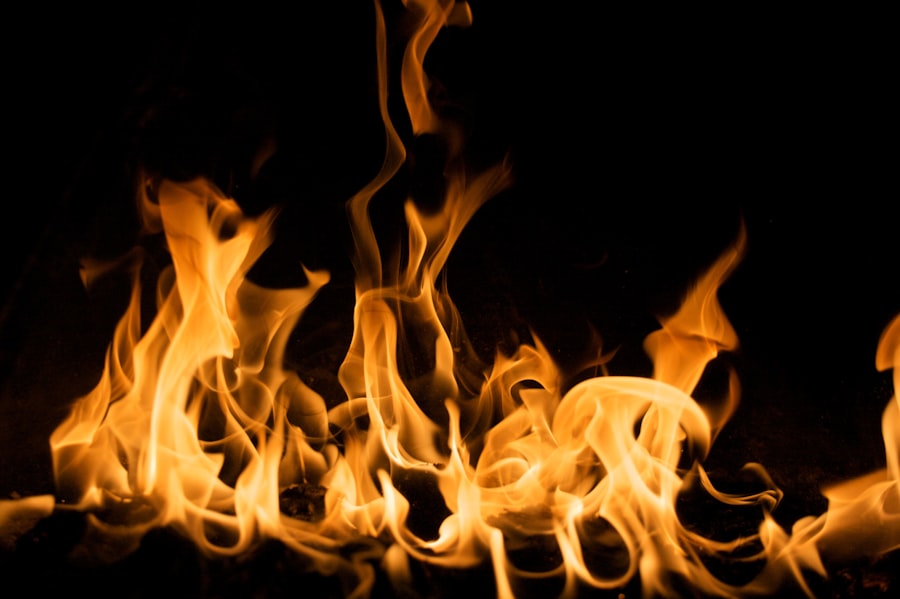Fire has been a force of nature that has both fascinated and terrified humans for centuries. From the simple act of creating fire for warmth and cooking to the devastating effects of wildfires and explosions, the study of fire has evolved into a complex and multi-disciplinary field known as fire studies. This field encompasses a wide range of scientific disciplines, including chemistry, physics, engineering, and forensic science, all of which are dedicated to understanding the behavior, causes, and effects of fires and explosions.
Key Takeaways
- Fire studies involve understanding the science of fire, investigating its causes, and exploring its impact on the environment.
- Fire dynamics play a crucial role in understanding how flames transform into explosions, leading to a deeper understanding of fire behavior.
- Fire studies are essential in forensic investigations, providing valuable insights into the causes and effects of fires and explosions.
- Advancements in fire safety and prevention are constantly evolving, with new technologies and strategies being developed to mitigate the risk of fires and explosions.
- The field of fire studies offers diverse career opportunities, including roles in fire investigation, fire safety engineering, and environmental impact assessment.
The Science of Fire: Understanding the Basics
At its core, fire is a chemical reaction known as combustion, which occurs when a fuel source combines with oxygen in the presence of heat. This process releases energy in the form of heat and light, which is what we commonly recognize as flames. Understanding the science behind fire involves delving into the chemical properties of different fuels, the role of oxygen in combustion, and the conditions necessary for a fire to ignite and sustain itself.
Additionally, the study of fire also involves understanding the behavior of flames, including how they spread and interact with different materials and environments. In recent years, advancements in technology have allowed scientists to gain a deeper understanding of the fundamental principles of fire. This has led to the development of sophisticated computer models and simulations that can accurately predict the behavior of fires in various scenarios.
These tools have not only enhanced our ability to study and analyze fires but have also contributed to the development of more effective fire safety measures and prevention strategies.
Investigating the Causes of Fires and Explosions
One of the key aspects of fire studies is the investigation of the causes of fires and explosions. This involves examining the circumstances surrounding a fire, identifying potential ignition sources, and determining the factors that contributed to its spread and intensity. In many cases, this process requires a thorough analysis of physical evidence, such as debris, burn patterns, and residue, as well as interviews with witnesses and experts in relevant fields.
The investigation of fires and explosions is often a collaborative effort that involves professionals from various disciplines, including fire investigators, forensic scientists, engineers, and law enforcement officials. Together, they work to piece together the puzzle of what happened before, during, and after a fire or explosion, with the ultimate goal of determining its cause and preventing similar incidents in the future.
Fire Dynamics: How Flames Transform into Explosions
| Topic |
Metrics |
| Fire Behavior |
Temperature, Fuel Type, Ignition Source |
| Fire Spread |
Rate of Spread, Direction, Fuel Moisture |
| Fire Suppression |
Water Usage, Extinguishing Agents, Effectiveness |
| Fire Ecology |
Impact on Ecosystems, Wildlife, Vegetation |
While flames are a common manifestation of fire, they can also transform into more destructive phenomena known as explosions. Understanding the dynamics of how flames transition into explosions is a critical aspect of fire studies, as it can help predict and mitigate the potential hazards associated with such events. Explosions occur when a rapid release of energy causes a sudden increase in pressure, resulting in a shockwave that can cause significant damage to surrounding structures and pose serious risks to human safety.
The study of fire dynamics involves analyzing the factors that can lead to explosive events, such as the presence of flammable gases or dust, confined spaces, and ignition sources. By understanding these factors, scientists and engineers can develop strategies to prevent explosions from occurring or minimize their impact if they do happen. This knowledge is particularly important in industrial settings where the handling and processing of flammable materials pose a constant risk of explosion.
The Role of Fire Studies in Forensic Investigations

Fire studies play a crucial role in forensic investigations, particularly in cases involving arson, explosions, or other fire-related crimes. Forensic fire investigators use their knowledge of fire behavior and dynamics to analyze evidence from crime scenes and determine whether a fire was deliberately set or occurred accidentally. This often involves examining burn patterns, residue, and other physical evidence to identify potential accelerants or ignition sources.
In addition to criminal investigations, fire studies also contribute to understanding the cause and origin of fires in accidents or natural disasters. By applying scientific principles to analyze fire-related incidents, forensic experts can provide valuable insights that help determine liability, improve safety standards, and prevent similar incidents from occurring in the future.
Advancements in Fire Safety and Prevention
The field of fire studies has led to significant advancements in fire safety and prevention measures. Through research and experimentation, scientists have developed innovative technologies and materials that can help reduce the risk of fires and limit their spread. This includes the development of flame-retardant materials, automatic fire suppression systems, and improved building codes that prioritize fire resistance.
Furthermore, advancements in fire studies have also contributed to the development of more effective firefighting techniques and equipment. From improved firefighting foams to advanced thermal imaging cameras, these innovations have enhanced firefighters’ ability to combat fires more safely and efficiently.
Exploring the Impact of Fires and Explosions on the Environment
Fires and explosions can have far-reaching impacts on the environment, from air pollution caused by smoke and ash to soil contamination from hazardous materials released during an incident. The study of these environmental impacts is an important aspect of fire studies, as it helps us understand how fires and explosions affect ecosystems and human health. In addition to immediate environmental effects, fires and explosions can also contribute to long-term ecological changes, such as deforestation, loss of habitat for wildlife, and changes in soil composition.
By studying these impacts, scientists can develop strategies for mitigating environmental damage caused by fires and explosions and promote sustainable recovery efforts.
Career Opportunities in the Field of Fire Studies
The field of fire studies offers a wide range of career opportunities for individuals interested in pursuing a career in fire science, engineering, or forensic investigation. Professionals in this field may work as fire investigators, forensic scientists specializing in fire analysis, fire protection engineers, or researchers studying fire behavior and dynamics. Additionally, there are opportunities for individuals with backgrounds in environmental science or public policy to work on developing regulations and policies aimed at preventing fires and mitigating their impact on communities and ecosystems.
As the demand for expertise in fire studies continues to grow, so too do opportunities for individuals looking to make a difference in this critical field. In conclusion, fire studies encompass a diverse range of scientific disciplines that are dedicated to understanding the behavior, causes, and effects of fires and explosions. From investigating the causes of fires to developing advanced fire safety measures, this field plays a crucial role in protecting lives, property, and the environment.
As our understanding of fire continues to evolve through research and technological advancements, so too will our ability to prevent and mitigate the devastating effects of fires and explosions.
FAQs
What is fire studies?
Fire studies is a multidisciplinary field that focuses on understanding the science, behavior, and impact of fires. It encompasses various areas such as fire dynamics, fire chemistry, fire safety engineering, and fire investigation.
What are the applications of fire studies?
Fire studies have numerous practical applications, including developing fire safety measures for buildings and structures, improving firefighting techniques, understanding the behavior of wildfires, and investigating the causes of fires for forensic purposes.
What are the key areas of research in fire studies?
Key areas of research in fire studies include fire dynamics, combustion processes, heat transfer in fires, fire modeling, fire suppression methods, fire-resistant materials, and the environmental impact of fires.
Why is fire studies important?
Fire studies are important for enhancing fire safety, preventing fire-related accidents, understanding the behavior of fires in different environments, and developing effective strategies for fire management and mitigation.
What are some career opportunities in fire studies?
Career opportunities in fire studies include fire safety engineering, fire investigation, firefighting, research and development of fire protection systems, fire risk assessment, and consulting for fire safety regulations and standards.
 Fire studies play a crucial role in forensic investigations, particularly in cases involving arson, explosions, or other fire-related crimes. Forensic fire investigators use their knowledge of fire behavior and dynamics to analyze evidence from crime scenes and determine whether a fire was deliberately set or occurred accidentally. This often involves examining burn patterns, residue, and other physical evidence to identify potential accelerants or ignition sources.
In addition to criminal investigations, fire studies also contribute to understanding the cause and origin of fires in accidents or natural disasters. By applying scientific principles to analyze fire-related incidents, forensic experts can provide valuable insights that help determine liability, improve safety standards, and prevent similar incidents from occurring in the future.
Fire studies play a crucial role in forensic investigations, particularly in cases involving arson, explosions, or other fire-related crimes. Forensic fire investigators use their knowledge of fire behavior and dynamics to analyze evidence from crime scenes and determine whether a fire was deliberately set or occurred accidentally. This often involves examining burn patterns, residue, and other physical evidence to identify potential accelerants or ignition sources.
In addition to criminal investigations, fire studies also contribute to understanding the cause and origin of fires in accidents or natural disasters. By applying scientific principles to analyze fire-related incidents, forensic experts can provide valuable insights that help determine liability, improve safety standards, and prevent similar incidents from occurring in the future.
 Fire studies play a crucial role in forensic investigations, particularly in cases involving arson, explosions, or other fire-related crimes. Forensic fire investigators use their knowledge of fire behavior and dynamics to analyze evidence from crime scenes and determine whether a fire was deliberately set or occurred accidentally. This often involves examining burn patterns, residue, and other physical evidence to identify potential accelerants or ignition sources.
In addition to criminal investigations, fire studies also contribute to understanding the cause and origin of fires in accidents or natural disasters. By applying scientific principles to analyze fire-related incidents, forensic experts can provide valuable insights that help determine liability, improve safety standards, and prevent similar incidents from occurring in the future.
Fire studies play a crucial role in forensic investigations, particularly in cases involving arson, explosions, or other fire-related crimes. Forensic fire investigators use their knowledge of fire behavior and dynamics to analyze evidence from crime scenes and determine whether a fire was deliberately set or occurred accidentally. This often involves examining burn patterns, residue, and other physical evidence to identify potential accelerants or ignition sources.
In addition to criminal investigations, fire studies also contribute to understanding the cause and origin of fires in accidents or natural disasters. By applying scientific principles to analyze fire-related incidents, forensic experts can provide valuable insights that help determine liability, improve safety standards, and prevent similar incidents from occurring in the future.

